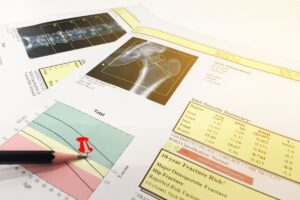Has your doctor told you that you have osteoporosis and prescribed medication? Perhaps you walked out of the office not surprised by the diagnosis but by what you found when digging deeper into the treatment methods. Like hormone therapy, osteoporosis medications have risks and benefits, but there are also risks to not treating it. Women+ should take bone health seriously and understand the treatment options.
Osteoporosis medications
Once you’re diagnosed with osteoporosis, there is no cure. But you can treat it with osteoporosis medication. Some drugs can even help rebuild some bone.
Osteoporosis medication can also help prevent it if you’re at significant risk. All women+ face some risk of osteoporosis, as you can lose up to 20% of your bone density during the menopause journey.
You have lots of options when talking to your doctor about osteoporosis medications. Ask about the following:
- types/benefit
- class of drug
- side effects
- delivery methods (pill, IV, patch)
- how long you should use it
- possibility of a second medication after you stop taking the initial prescription
So, let’s break it all down.
Types/Benefits
There are two main types of osteoporosis medications, each with different benefits. There are those that:
- Prevent more bone loss and reduce the risk of a break – antiresorptive drugs like bisphosphonates and
- Rebuild bone and reduce fracture risk – anabolic
Classes/Brands
Within those types of medication, you may also see these classes of drugs mentioned.
| Class | Drug | Brand | Length |
|---|---|---|---|
| Bisphosphonates | Alendronate, Risedronate, Ibandronate, Zoledronic acid | Fosamax®, Fosamax Plus D™ Binosto®, Boniva®, Actonel®, Atelvia™, Reclast® | up to 5 years orally up to 3 years, through IV |
| Selective estrogen receptor modulators (SERMS) | Raloxifene | Evista® | As directed by your doctor. |
| Tissue-Specific Estrogen Complex | Bazedoxifene | Duavee® | Shortest time possible, and only as long as needed. |
| Parathyroid Hormone (PTH) | Teriparatide | Forteo®, Bonsity® | up to 2 years |
| Parathyroid Hormone-Related Protein (PTHrp) | Abaloparatide | Tymlos® | no longer than 2 years |
| Sclerostin Inhibitor | Romosozumab | Evinity® | 12 months |
| Hormone therapy | Estrogen, progesterone | Prempro® and others | Talk to your doctor. |
| Calcitonin | Calcitonin-salmon (rdDNA origin) | Fortical®, Miacalcin® | Talk to your doctor. |
| Monoclonal antibody targeting RANK ligand (RANKL) | Denosumab | Prolia® | Up to 10 years |
If you use hormone therapy, it is used only for the prevention of bone loss. It is not used for the treatment of osteoporosis.
Each osteoporosis medication has its particular way of working, side effects, etc., which you can learn about in detail on Drugs.com or the manufacturer’s website.
With some, it’s recommended that you take a second medication after you stop taking the first one. With others, your doctor may recommend a drug holiday.
Delivery types
There are also several delivery methods, including:
- Pills
- Injections
- Skin patches
- Nasal spray
- IV therapy

Updated treatment guidelines
Like hormone therapy, which also has guidelines to consider (weighing the pros and cons of treatment), there’s also a set of recommendations for osteoporosis medication.
The American College of Obstetricians and Gynecologists (ACOG) 2023 recommendations indicate:
- Bisphosphonates are the first treatment option, except for women at very high risk of fracture. Also, The Menopause Society says women at high risk of impaired renal function should use bisphosphonates with caution.
- Take them for up to five years if taken orally.
- Take them for up to three years if taken by IV.
- Women+ at risk of high fracture should use either romosozumab or teriparatide followed by a bisphosphonate.
- Denosumab injections every six months help bone density faster than bisphosphonates. But, improvements fade in months when you discontinue the injections unless you take bisphosphonates.
- Parathyroid hormone analog treatment dramatically improves density and reduces fractures when taken for up to two years. However, it requires subsequent bisphosphonates to maintain benefits.
- One year of romosozumab followed by one year of alendronate reduces the fracture risk more than two years of alendronate therapy alone.
When talking to your doctor about a treatment plan, know that you may be prescribed a different medication at different stages of the menopause journey.
Which doctor do you see for osteoporosis?
You can get a diagnosis and treatment plan from your:
- gynecologist
- family doctor
- rheumatologist
- geriatrician
- orthopedic surgeon
- endocrinologist
A physical therapist can also help with exercises following a fracture.
What are bisphosphonates?
This type of osteoporosis medication is usually the first treatment option for osteoporosis and is also recommended after taking some other medications.
These types of drugs go by brand names like Fosamax®, Actonel®, Reclast®, and Binosto®.
These medications:
- strengthen your bones
- help prevent future breaks
- slow bone loss
They are given either with a pill or via an IV.
Bisphosphonates side effects
There are common side effects with bisphosphonate treatment:
- reflux and GI irritation
- flu-like symptoms with IV treatment
- musculoskeletal pain
- transient hypocalcemia (low calcium level), most commonly with IV therapy
- atrial fibrillation (conflicting studies)
- inflammation of the eye
- osteonecrosis of the jaw (ONJ) – death of bone tissues due to the disruption of blood flow; can lead to bone breakdown and collapse
- fractures of the femur in the thigh
- esophageal cancer (conflicting studies)
After the FDA raised the concerns about fractures and esophageal cancer, utilization of bisphosphonate in Medicaid programs decreased by 22%.
If you take bisphosphonates, they’re most effective at limiting fracture risk when taken with enough calcium and vitamin D.

Reflux with bisphosphonates
GI issues are some of the most common side effects of taking bisphosphonates, including heartburn and stomach upset. You’re advised to sit upright for 30 to 60 minutes after taking the medication. Do not lie down during this time to help minimize this side effect.
Also, don’t eat during this time as the stomach does not absorb the pills well.
If you struggle with GI issues, which can worsen during the menopause journey, you can get the medication through an IV, which helps reduce these side effects. With IV therapy, you also don’t have to get the medication as often.
IV side effects
While IV therapy can help reduce the reflux experienced with oral bisphosphonates, IV therapy has its own set of side effects. These can include flu-like symptoms – fever, muscle and joint pain, and headache.
Treatment length
Treatment length varies, but it’s typically not a lifetime drug. With IV therapy, you usually receive treatment for three years and five years with oral therapy.
There have also been concerns raised about the crumbling of the jawbone.
Like HT, there’s a question of what length of time is safe and beneficial for the use of osteoporosis drugs. The FDA pointed out in 2010 that the “optimal duration of use has not been determined” but advised women to stop use after 3-5 years if the risk of fracture is low.
In 2012, the FDA reiterated that women without osteoporosis experience few to no benefits when taking medications longer than five years.
New guidelines in February 2023 from the American College of Physicians (ACP) suggest a risk-benefit imbalance after 5 years of use due to potential long-term harms if taken for a longer period of time. Additionally:
- preferential use of bisphosphonates as first-line therapy in osteoporosis, except for women at very high risk of fracture
- for those at very high risk of fracture, either romosozumab or teriparatide, followed by a bisphosphonate
As always, a discussion with your healthcare practitioner is critical to determine the best course of action in your particular circumstance.
What is a bisphosphonate drug holiday?
Unlike other osteoporosis drugs, bisphosphonates stay in your body for an extended period of time after treatment ends.
So, your doctor may talk about a bisphosphonate drug holiday. It’s a temporary pause in treatment.
Your doctor will closely watch to determine if/when to restart therapy when needed to prevent a fracture.
Why was Boniva® taken off the market?
Boniva® is a type of bisphosphonate whose active ingredient is ibandronate. It was a popular medication that was taken off the market in the United States. So be aware that you may continue to find mention of it during internet searches, and generic versions that are sold illegally are still available.
Additionally, there is current litigation against the Fosamax version of alendronate related to osteonecrosis of the jaw.
However, the generic form of ibandronate tablets and IV injections are still available.
Talk to Your Doctor
How long should you take other types of osteoporosis medications?
Some drugs have long-lasting effects even after you stop the osteoporosis medication, while others leave the body faster.
Like hormone therapy, talk to your doctor about an individualized treatment approach based on your history, risk factors, and preferences.
There are some timelines:
- Teriparatide – Forteo® and Bonsity® – anabolic Parathyroid hormone (PTH) injections – taken for up to 2 years
- Abaloparatide – Tymlos® – anabolic Parathyroid Hormone-Related Protein (PTHrp) injection – do not use longer than 2 years
- Romosozumab-aqqg – Evenity® – Sclerostin inhibitor injection – taken for 12 months
Can you reverse osteoporosis?
While these medications will help, and anabolic drugs will rebuild bone, you can’t reverse osteoporosis.
It’s an incurable disease, but there are treatment options.
You can also help prevent it with food and exercise. Screenings are also important so you can identify it early and prevent a serious injury like a hip fracture.
Lifestyle tips to support bone health
In addition to medication, you should also make lifestyle changes to help prevent and manage osteoporosis. It’s never too late to start supporting your bone health.
These lifestyle changes can also help prevent other muscle aches and pains associated with the menopause journey. These can include frozen shoulder, ligament or tendon damage, joint paint, and loss of muscle mass and strength. These conditions, along with osteopenia (bone thinning) and osteoporosis (bone loss), are known as the musculoskeletal syndrome of menopause (MSM).
In osteoporosis 101, we show you how to improve your bone health and reduce the risk of developing osteopenia (stage before osteoporosis) and osteoporosis with/by:
- Exercise
- Maintenance of an adequate vitamin D level
- Maintaining a healthy diet
- Limiting/eliminating alcohol
- Stopping smoking
- Adding safety measures at home to prevent falls in each room of your home.
Here’s a Healthy Bones Toolbox to help! It includes information from bone health experts, with 11 exercise demonstrations and 11 bone health discussions from Margie Bissinger, MS, PT, CHC of Happy Bones, Happy Life™.
There are various treatment options, even though osteoporosis is an incurable disease.
Be proactive rather than waiting for a break that could have a devastating impact on your life. Speak with your healthcare practitioner so you can make a change for the better!
Medicines for Prevention and Treatment | Bone Health & Osteoporosis Foundation
Drug therapy for osteoporosis | The Lancet
The 2022 hormone therapy position statement of The North American Menopause Society (now The Menopause Society). Menopause: The Journal of The North American Menopause Society. 2022. Vol. 29, No. 7, pp. 767-794. DOI: 10.1097/GME.0000000000002028
Find Drugs & Conditions | Drugs.com
Osteoporosis Treatment: Updated Guidelines From ACOG | American Family Physician
The Menopause Society (formerly The North American Menopause Society). Management of osteoporosis in postmenopausal women: the 2021 position statement of The North American Menopause Society. Menopause: The Journal of The North American Menopause Society. 2021. Vol. 28, No. 9, pp. 973-997 DOI: 10.1097/GME.0000000000001831
Kennel KA, Drake MT. Adverse effects of bisphosphonates: implications for osteoporosis management. Mayo Clin Proc. 2009 Jul;84(7):632-7; quiz 638. doi: 10.1016/S0025-6196(11)60752-0. PMID: 19567717; PMCID: PMC2704135.
FDA Drug Safety Communication: Safety update for osteoporosis drugs, bisphosphonates, and atypical fractures | U.S. Food & Drug Administration
FDA Drug Safety Communication: Ongoing safety of review of oral osteoporosis drugs (bisphosphonates) and potential increased risk of esophageal cancer | U.S. Food & Drug Administration
Balkhi B, Seoane-Vazquez E, Rodriguez-Monguio R. Changes in the utilization of osteoporosis drugs after the 2010 FDA bisphosphonate drug safety communication. Saudi Pharm J. 2018 Feb;26(2):238-243. doi: 10.1016/j.jsps.2017.12.005. Epub 2017 Dec 8. PMID: 30166922; PMCID: PMC6111194.
Kennel KA, Drake MT. Adverse effects of bisphosphonates: implications for osteoporosis management. Mayo Clin Proc. 2009 Jul;84(7):632-7; quiz 638. doi: 10.1016/S0025-6196(11)60752-0. PMID: 19567717; PMCID: PMC2704135.
Side Effects of Bisphosphonates (Alendronate, Ibandronate, Risedronate and Zoledronic Acid) | Bone Health & Osteoporosis Foundation
Bisphosphonates | Cleveland Clinic
Qaseem A, Hicks L, Etxeandia-Ikobaltzeta I, Shamliyan T, Cooney T. Pharmacologic Treatment of Primary Osteoporosis or Low Bone Mass to Prevent Fractures in Adults: A Living Clinical Guideline From the American College of Physicians. Annals of Internal Medicine. 2023. Volume 176, Issue 2. doi: 10.7326/M22-1034
Generic Boniva Availability | Drugs.com
Fosamax vs. Prolia vs. Boniva: Which Is the Best Osteoporosis Treatment? | GoodRx Health
Forteo® | Eli Lilly and Company
Tymlos® | Radius Health
Tymols® Medication Guide | Radius Health
Evenity® | Amgen Inc.
Vitamin D | International Osteoporosis Foundation
Preventing Falls at Home: Room by Room | National Institute on Aging
Healthy Bones Toolbox | Happy Bones, Happy Life™
You may also like…

What You Need to Know About the Musculoskeletal Syndrome of Menopause
Feeling new joint pain even though you don’t have an injury? Musculoskeletal syndrome of menoapuse can cause aches and pains. Get treatment.

28 At-Home Osteoporosis Exercise Videos To Help Prevent or Manage It
Try these at-home osteoporosis exercise videos from our collaborative partner. They can help prevent or manage osteoporosis and osteopenia.

Osteoporosis 101: Know What To Look For and Foods That Can Help Prevent It
Osteoporosis is often undiagnosed and untreated in post-menopausal women+. It’s not curable, so prevent it with these foods and other lifestyle changes.

